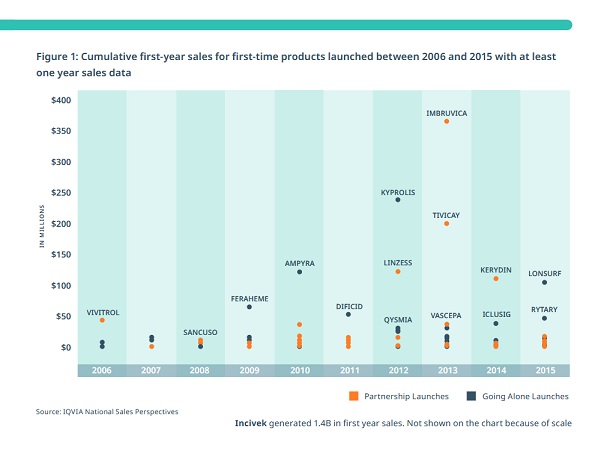https://www.iqvia.com/-/media/iqvia/pdfs/us-locati
Post# of 157755
Make a Deal...or Not?
Quote:
Between 2006 and 2015, 105 companies – the majority of which were in the U.S. – launched a product for the first time.
Quote:
Recognizing the dilemma, IQVIATM Biotech analyzed the approaches of companies that launched products for the first time between 2006 and 2015 to understand their funding/commercialization strategies.

Quote:
Going it Alone produces twice as many medium-sized companies (those with first-year sales of $101-500 million) than does partnering. Figure 4 illustrates that even though emerging companies have far less “promotional muscle” when they enter the market on their own, their first-year revenues are not dramatically less than if they had entered into a partnership.3
Quote:
Going it Alone, however, appears to be riskier when it comes to negotiating with payers. Of those launches that faced high payer rejection rates, a larger percentage (50 versus 32) were introduced by companies Going it Alone than by those in partnerships. (
Quote:
For commercialization, more emerging companies opt to go it alone than to partner with a large pharmaceutical company. The split is approximately 60/40 between Going it Alone and partnering.
• In terms of first-year sales, Going it Alone appears to be more profitable for the originator than partnering. Going it Alone produces twice as many medium-sized companies in the first year than does partnering. This is true despite the emerging company’s smaller promotional capabilities.
• One of the main short-term benefits of partnering may be in negotiating with payers. Companies Going it Alone are more likely to face payer high rejection rates than those in partnerships.
• The long-term benefits of partnering were not explored in this research, but logic suggests that they might include support with subsequent launches, ongoing leverage with stakeholders, and greater promotional muscle.
• Success for first-time launchers hinges on having a high-value product and access to capital. To be successful, new products have to offer patients better outcomes, either in terms of fewer side effects, fewer hospitalizations, improved Quality of Life, increased productivity, or longer survival .
There are ample examples of successful launches under both models – Going it Alone and partnering. In general, successful first-time launches are high-value products that fall into the IQVIA Biotech Archetypes: Science Sells, Market Shaping and Emphasize the Difference.
 (0)
(0) (0)
(0)